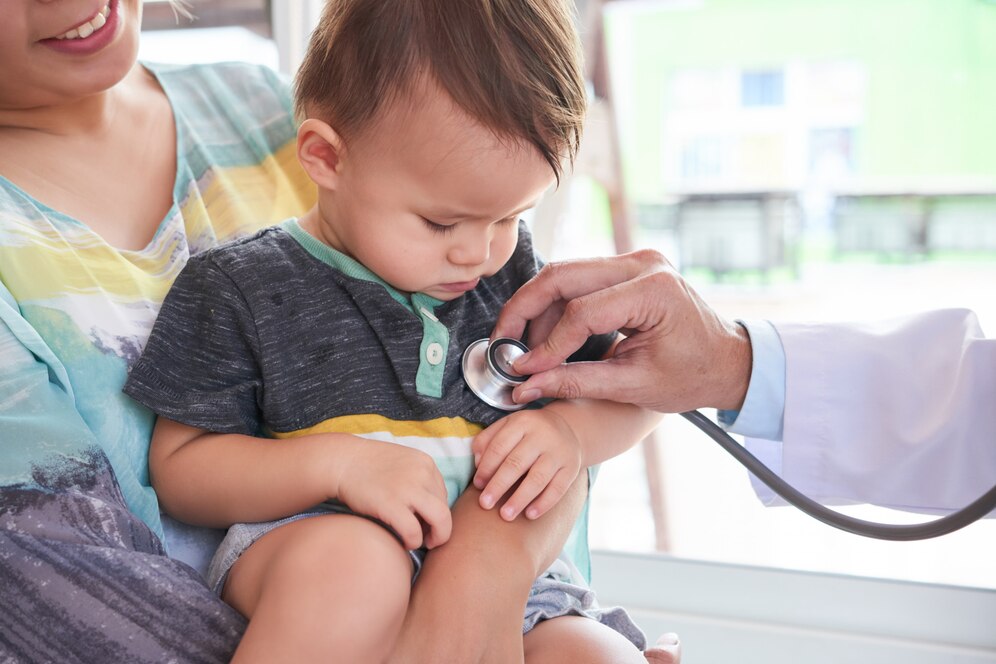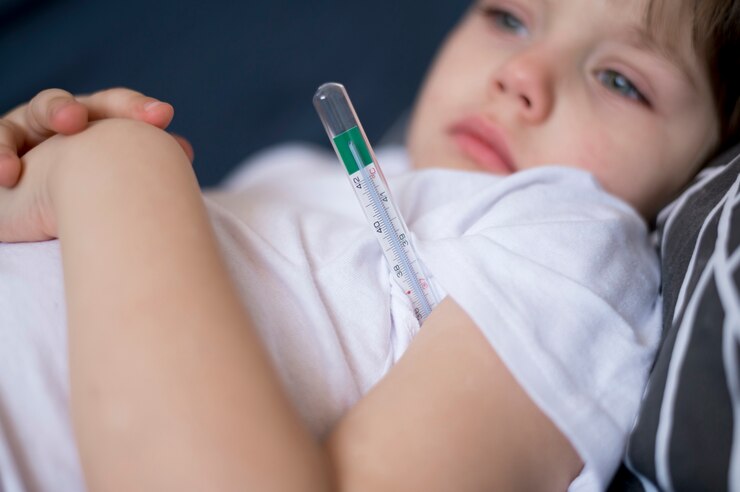


The Pediatric Cardiology Department provides diagnostic and therapeutic services for cardiac issues in patients from fetal stage to adolescence (up to 18 years). Common pediatric cardiac conditions include congenital heart diseases (e.g., atrial septal defects, ventricular septal defects), acquired heart diseases (e.g., rheumatic valve diseases, infectious diseases), and cardiac rhythm disorders.
Initial patient symptoms often include murmur, cyanosis, reduced exercise capacity, chest pain, palpitations, dizziness, syncope, or elevated blood pressure. Diagnostic approaches typically involve electrocardiography (ECG), telecardiography, and echocardiography (ECHO), with fetal ECHO used to assess fetal heart conditions. Additional diagnostic tools may include exercise tests, HOLTER monitoring, cardiac catheterization, and angiography. Children engaged in sports are also evaluated for cardiac health risks.

Heart Structure and Function
The heart consists of four chambers: two upper atria and two lower ventricles. The atria receive blood from the veins, while the ventricles pump blood out to the lungs and body. The heart operates through a series of contractions, distributing oxygenated blood to the body and returning deoxygenated blood to the lungs. This cycle is essential for maintaining oxygen supply to the body’s organs.
Congenital Heart Diseases
Congenital heart diseases are structural abnormalities present from birth, affecting about 8 in 1,000 newborns. These can range from minor holes in the heart’s walls to more severe malformations. The causes of congenital heart diseases are often multifactorial, involving a combination of genetic and environmental factors.

Congenital heart diseases (CHD) manifest during the very early stages of pregnancy, often before organ formation is initiated. The exact causes remain unclear for most instances. While some CHDs are hereditary, only a few conditions show a clear genetic link. Genetic disorders such as Down Syndrome and Turner Syndrome are known to elevate the risk of CHDs. Additionally, maternal factors like certain medications, infections (e.g., Rubella), and exposure to radiation during the first trimester can contribute to the development of these heart conditions. Often, no specific cause can be identified even with a thorough family history, leading to the consensus that CHDs result from a combination of genetic and environmental factors. Diagnostic procedures like fetal echocardiography can help detect CHD before birth.
CHDs encompass a wide spectrum of heart anomalies. While some individuals may exhibit no symptoms or only mild ones, others experience severe and life-threatening symptoms early on. These include cyanosis, feeding difficulties, fatigue, elevated respiratory rates, shortness of breath, failure to thrive, and frequent respiratory infections such as bronchitis or tuberculosis. Older children might show symptoms like reduced exercise tolerance, palpitations, chest pain, and syncope. In some cases, the only finding might be an 'Innocent murmur' detected during a routine physical examination.

Children with CHDs may need specific care depending on the type and severity of their condition. General guidelines often include the use of antibiotics during specific interventions to prevent infective endocarditis, a potentially life-threatening condition. Families should be well-informed about the preventive measures and the necessary details regarding the duration and dosage of antibiotic therapy, as outlined in the "Infective Endocarditis Prevention Guideline." While many children with CHD do not require activity restrictions, those with certain conditions should avoid strenuous activities as determined by a pediatric cardiologist. Nevertheless, physical activities are encouraged to support psychological well-being and improve cardiac function. Additionally, children with CHD should receive standard vaccinations and may require additional vaccines under certain conditions.
What Is Infective Endocarditis?
Infective endocarditis is an inflammation of the endocardium, heart valves, or cardiac vessels, more common in children with pre-existing heart conditions. The causative agents are typically bacteria from the oral cavity, which pose no threat to healthy individuals but can lead to severe infections in those with CHD if they enter the bloodstream. This underscores the importance of oral hygiene and regular dental visits for children with heart conditions. Preventive antibiotics may be prescribed during high-risk procedures that could introduce bacteria into the bloodstream, such as dental work or surgeries involving the tonsils, adenoids, urinary tract, or reproductive systems.
A murmur is a blowing sound heard during cardiac auscultation caused by abnormal blood flow within the heart or blood vessels. While murmurs are common in various heart conditions, the most prevalent type in children without heart disease is the 'Innocent murmur' or 'physiological murmur' indicating no underlying heart disease. An experienced physician can usually discern whether a murmur is innocent. If uncertainty remains, the patient may be referred to a pediatric cardiologist, and echocardiography may be utilized to definitively diagnose the nature of the murmur.
What is Fetal Echocardiography?
Fetal echocardiography is a specialized ultrasound technique used to assess the heart of a fetus during the intrauterine period. Ultrasound, a long-standing, safe imaging method in medicine, employs sound waves and is known to pose no harm to either the baby or the mother. The fetal heart can typically be visualized starting from a gestational age of 16-18 weeks, with the most effective imaging occurring between 20 to 24 weeks.

Advanced maternal age (over 35), multiple gestations (twins, triplets), and pregnancies resulting from In-vitro fertilization are also circumstances where fetal echocardiography is recommended.

Fetal echocardiography is a non-invasive diagnostic procedure performed to assess the cardiac health of an unborn baby. Using an ultrasound transducer placed on the mother's abdomen, this pain-free examination scans the fetus to create images of the baby's heart. The clarity and detail of these images can be influenced by factors such as gestational age, fetal position, maternal body composition, placental location, and the quality of the ultrasound device.
The duration of an echocardiographic study generally ranges from 15 to 30 minutes. However, this may extend if the initial images are unclear or if there is suspicion of a complex cardiac anomaly. Diagnosing certain congenital heart defects during pregnancy is feasible, although some conditions can be challenging to identify. For lesions that may progress, repeating the scan at regular intervals is advisable. The diagnostic accuracy of this method ranges from 65 to 90 percent, contingent on image quality.
In cases where fetal echocardiography identifies a potential issue, intervention is typically not necessary immediately. Post-birth, the infant is monitored periodically through echocardiography. Severe cardiac conditions may necessitate early surgical interventions or other invasive procedures. Pregnant women carrying fetuses with critical heart diseases are advised to deliver in hospitals equipped to provide immediate neonatal care. In rare cases with grave prognoses where conditions cannot be fully corrected surgically, the option of pregnancy termination may be discussed with the family by a team of pediatric cardiologists and cardiovascular surgeons, based on the family's decision.
Some cardiac conditions can be managed prenatally by administering specific medications to the mother.

Acute rheumatic fever, commonly known as heart rheumatism or simply rheumatism, is an inflammatory disease triggered by Group A beta-hemolytic streptococcus—the same bacterium that causes pharyngitis and tonsillitis. Typically affecting children aged 5 to 15 years, the disease manifests approximately 2-3 weeks after a streptococcal throat infection. If not adequately treated with antibiotics, the risk of developing rheumatic fever increases, though it remains minimal with appropriate medical management.
Symptoms primarily involve inflammation in the joints, heart, brain, occasionally the skin, presenting as joint swelling, pain, warmth, and slight redness, typically in the knees, wrists, and ankles. The most significant impact is on the heart, leading to valve damage and dysfunction. Additional manifestations may include involuntary movements (chorea), behavioral changes, and, rarely, dermatological signs. Immediate treatment and follow-up are crucial upon diagnosis.
While mild cases of heart valve diseases can be potentially reversible if treated early, the damage is predominantly irreversible.
Only throat infections caused by Group A beta-hemolytic streptococcus can lead to rheumatism. Other viral and bacterial infections do not cause this condition. Diagnosis typically requires a throat culture among other examinations, with symptoms including sore throat, difficulty swallowing, fever, and painful neck swellings.

Children with a history of rheumatic fever face a high risk of recurrent infection. Preventative measures include long-term antibiotic protection, either through regular intramuscular injections of penicillin every three weeks or daily antibiotic tablets. These preventive measures should continue lifelong if the heart is involved or until the age of 21 otherwise.
As with congenital heart diseases, rheumatic heart disease increases the risk of infective endocarditis, necessitating diligent oral and dental hygiene. Depending on the severity of the condition, exercise and dietary restrictions may also be required.
Though more commonly associated with adults, chest pain is the third most common type of pain in children, following headaches and abdominal pain. In children, chest pain is primarily musculoskeletal, related to the chest wall, but can also originate from lung diseases, asthma, gastrointestinal disorders, heart diseases, or psychological factors. Pain stemming from heart diseases, though rare, is particularly concerning and warrants thorough investigation, especially if associated with symptoms like poor exercise capacity, fainting, and palpitations during or after physical activity.

Syncope, commonly known as fainting, is a temporary loss of consciousness caused by a sudden decrease in blood flow to the brain. It frequently occurs in healthy children and adolescents, with approximately half experiencing at least one episode by adolescence. While syncope can be alarming for families, it typically does not signify a severe condition. The most common form, "simple syncope" or vasovagal syncope, is often triggered by intense pain, anxiety, excitement, prolonged standing, exposure to heat, or the sight of blood. These episodes are generally brief and harmless.
However, syncope can occasionally indicate significant cardiac issues. Conditions such as heart muscle abnormalities, congenital heart defects, and arrhythmias (abnormal heart rates) may also cause syncope in children. It is crucial to evaluate the cardiovascular system thoroughly if syncope occurs alongside symptoms like exertional dizziness, chest pain, palpitations, reduced exercise capacity, or if there is a family history of syncope and sudden death.
Preceding symptoms of syncope may include dizziness, fatigue, blurry vision, nausea, and hot flashes. Falling during a syncope episode can lead to injuries. For non-cardiac-related simple syncope, elevating the patient's legs usually helps them regain consciousness within minutes. Treatment methods for other types of syncope depend on the underlying cause.

Sports activities impose significant demands on the heart, which can lead to cardiac issues in children who otherwise exhibit no symptoms in daily life. Increasing parental awareness, driven by reports of child and adolescent deaths during sports events, has highlighted the potential risks. These incidents, often labeled as ‘Heart attacks’ in the media, can stem from various etiologies distinctly different from adult heart attacks.
Children diagnosed with cardiac muscle diseases, specific congenital heart conditions, surgically treated heart diseases, or rhythm disorders are generally advised against participating in strenuous physical activities. Consequently, it is recommended that children engaged in intensive sports undergo a cardiac evaluation by a physician at least annually to ensure their cardiac health is not at risk.
